It’s easy to see why the various avenues to self-sufficiency, from homesteading to going off-grid, have gained traction among our readers in recent years. Not only is the lifestyle a natural fit for sturdy log and timber homes, it’s also a choice with many benefits: financial freedom, sustainability and a sense of accomplishment. Plus, for some homeowners, the remoteness of their property necessitates it.
From growing some of your own food in the back yard to total utility independence, there’s more than one way to embrace a more self-sufficient lifestyle. Here’s what you need to know about the different forms of living off the beaten path and where to start.
Homesteading 101
At its core, homesteading is a lifestyle that includes a commitment to some level of self-sufficiency. For the uncompromising, that means growing or raising all their food, supplying/building their shelter, generating their own power, making their own clothes and living without earning or spending money. Other homesteaders take a looser approach: They may work outside the home, purchase some goods or services and live in a house that’s tied to public utilities. Either way, living debt-free is a common theme for those in this growing movement.
Homesteading isn’t relegated to rural settings, however. Suburbanites and city dwellers alike also enjoy growing as much food as they can, bartering for necessities and generally simplifying their lifestyle.
Going Off-Grid
The definition of off-grid living varies widely depending on who you ask. Folks who consider themselves “off-grid” can fall anywhere on a large spectrum. The most basic definition is not being tied to public utilities.
Some people, in pursuit of a more rugged version of off-grid living, cut themselves off from the system completely and, in addition to sourcing water and power independently, they live without technology and adopt homesteading practices, like raising animals and growing produce.
Most off-grid homeowners also choose to live with fewer electrical appliances and, instead, choose alternative ways to do things. For example, they might wash the dishes by hand rather than having a dishwasher or heat food on a wood-fired stove rather than in a microwave.
Now, if you dream of building an off-grid cabin, you’ll want to ensure you choose the right setup to make the most of your natural surroundings. Some things you’ll need to consider when assessing properties include:
- Construction: Will crews be able to reach your site, if building new?
- Power: Disconnecting from the electrical grid and generating power via solar, wind, hydro or other is usually the defining step people take to move a home off the grid.
- Water: Sources often include rainwater collection, wells and water tanks. If you are relying on a natural source, ensure that it’s available all year, and consider how you will filter the water.
What is Right for You?
While off-grid living and homesteading are different principles, they go hand-in-hand. Homesteading is a lifestyle of self-sufficiency involving growing some of your own food and potentially raising livestock. Other, more hard-core, homesteaders will live as sustainably as possible by making their own clothes, preserving foods, and often living totally off-grid. Both ideals aim to live sustainably, however some homesteads are still connected to the grid. Conversely, some off-grid homes still rely on outside sources for food and supplies.
It all depends on your level of comfort. It never hurts to start small – maybe with a raised garden bed in the backyard and a solar panel or two – and grow from there.
Off the Grid, On Our Radar
For some, going off-grid means being offline — all the way offline. But for others, a little connectivity has cultivated a major online community. Check out these homesteading and off-grid living influencers who should be on your radar:
Homesteading Family
YouTube: @HomesteadingFamily
Learn more about sustainability and self-sufficiency from this family who shares glimpses of simple and serene country life via informative videos.
Jill Winger
Instagram: @jill.winger
Follow Jill for motivational, heartfelt reflections on homesteading mixed with practical advice and modern solutions, like the homesteading planner she created.
Wild Wonderful Off-Grid
YouTube: @WildWonderfulOffGrid
Get a behind-the-scenes look at what it’s like to pack up three kids and build your own off-grid, self-reliant life in West Virginia from scratch.









